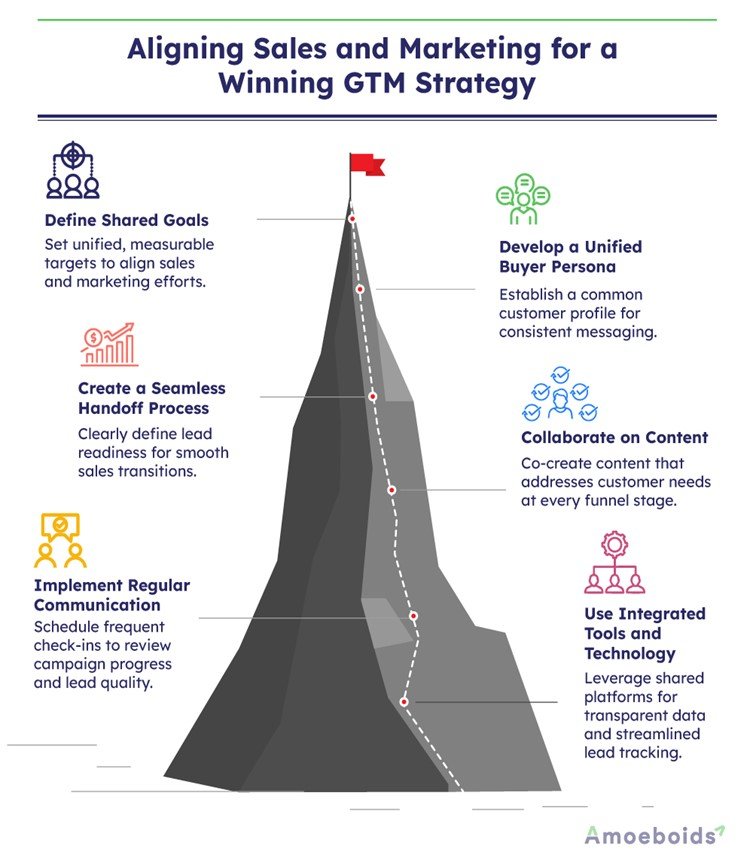How to Align Sales and Marketing Teams for a Successful GTM Strategy
- 1 Why Sales and Marketing Alignment Matters in a GTM Strategy
- 2 Challenges in Aligning Sales and Marketing for a GTM Strategy
- 3 Steps to Align Sales and Marketing Teams for a Successful GTM Strategy
- 4 The Role of Metrics and KPIs in a GTM Strategy
- 5 The Power of Feedback Loops in GTM Strategy Execution
- 6 Case Study of Successful Alignment
- 7 Conclusion
Imagine launching a groundbreaking product only to see it underperform due to a misalignment between your marketing and sales teams.
A solid GTM approach can help you close that gap in this situation.
Although a GTM strategy outlines how to launch your product, sales and marketing alignment is crucial to its success.
A smooth transition from lead generation to conversion occurs when these two essential teams are aligned.
This blog will discuss the need for sales and marketing alignment for GTM success and offer practical advice.
Let’s explore how teamwork can improve your approach!
Why Sales and Marketing Alignment Matters in a GTM Strategy
Missed revenue opportunities, conflicting messages, and substantial resource loss are the results of misaligning sales and marketing.
Imagine sales struggling to follow up because they aren’t focusing on the same consumer pain areas as marketing despite marketing’s tireless efforts to generate leads.
This misalignment affects your entire go-to-market strategy, resulting in poor ROI, teams, and communication.
Without clear communication, marketing may share content that sales can’t effectively use, leading to disengaged prospects and low conversion rates.
When these teams fail to collaborate, you risk wasting valuable time and potentially losing clients.
Optimizing your GTM strategy demands alignment, which is essential rather than optional.
Challenges in Aligning Sales and Marketing for a GTM Strategy
Several significant obstacles must be overcome to align sales and marketing with a GTM strategy:
- Communication Gaps: Missed opportunities and misalignment with client needs result from a lack of shared information.
- Goals at odds: Marketing promotes long-term growth, while sales frequently target short-term conversions, which causes conflict.
- Absence of Shared Data: Both teams find monitoring leads and improving tactics challenging when they cannot access the same customer data.
- Inefficiencies: Working in silos results in unqualified leads and underutilized content, hindering collaboration and GTM effectiveness.
Addressing these challenges can enhance teamwork and improve GTM execution.
Steps to Align Sales and Marketing Teams for a Successful GTM Strategy
The following six essential stages will help sales and marketing collaborate effectively for a successful GTM strategy:
Define Shared Goals: Set measurable objectives like revenue targets to unify efforts.
Develop a Unified Buyer Persona: Create a common understanding of the ideal customer for consistent messaging.
Create a Seamless Handoff Process: Define when leads are ready for sales to ensure smooth transitions.
Collaborate on Content: Work together to produce content that addresses customer needs throughout the sales funnel.
Implement Regular Communication: Meet regularly to discuss campaign progress and lead quality.
Use Integrated Tools and Technology: Utilize shared platforms for data transparency and better lead tracking.
These steps help teams collaborate effectively, ensuring a smooth and successful GTM strategy.
The Role of Metrics and KPIs in a GTM Strategy
Metrics and KPIs are essential to a successful GTM strategy because they help the marketing and sales teams stay in sync:
- Same Metrics promotes unity: By concentrating marketing and sales on the same KPIs, it is feasible to ensure that both teams pursue the same goals, advancing collaboration.
- KPIs Direct Adjustments in Real Time: Reviewing essential indicators regularly enables strategic adjustments, maintaining teams’ flexibility and effectiveness.
- Collaborative Data Review: When sales and marketing analyze performance, they can optimize efforts for better results.
Shared KPIs keep everyone focused and drive a successful GTM strategy.
The Power of Feedback Loops in GTM Strategy Execution
Harnessing the potential of feedback loops is essential for refining your GTM strategy.
Below are key aspects that highlight how continuous communication and adjustments can enhance alignment between sales and marketing teams:
- Continuous Feedback Fuels Improvement: Regular input between sales and marketing teams ensures each department adjusts based on real-time insights, refining efforts to stay aligned.
- Real-Time Adjustments for Better Results: Marketing can tweak campaigns based on sales insights to generate more qualified leads, creating a cycle of ongoing optimization.
- Example: For instance, if sales notice specific leads aren’t converting, marketing can adjust targeting or messaging to focus on higher-quality prospects, leading to better results across the board.
Feedback loops create a dynamic system where both teams stay agile, ensuring sustained GTM success.
Case Study of Successful Alignment
Salesforce launched a tailored brand campaign in India to improve brand perception among mid-market decision-makers, acknowledging that global campaigns weren’t meeting local needs.
The eight-week initiative included print, display, online video, and out-of-home ads, with LinkedIn as the sole social media platform.
By collaborating with LinkedIn Marketing Solutions, Salesforce optimized ads with localized messaging and endorsements, doubling engagement rates.
Employees acted as brand ambassadors, generating over 40,000 engagements.
This effort resulted in a 170% increase in the share of feed share to competitors, reaching 2.3 million people and significantly enhancing brand awareness.
Internal metrics showed improved perceptions, highlighting Salesforce’s commitment to supporting Indian businesses.
Conclusion
Aligning sales and marketing teams is essential for a successful GTM strategy.
Collaboration towards shared objectives enhances lead generation, conversion rates, and revenue growth.
Key takeaways include the importance of a unified approach that meets customer needs and builds stronger relationships.
Product managers, CMOs, and leaders must act now to create alignment strategies, foster collaboration, track progress with shared metrics, and ensure open communication.
The success of your GTM strategy relies on it!


















